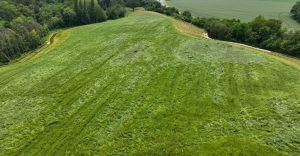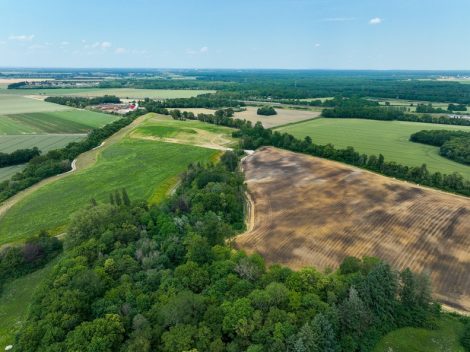The Grisy-Suisnes project is coming to an end after four years of soil transfer. On this occasion, our partner SAFER IDF is looking to highlight this environmental restoration and agricultural renewal project.
Could you briefly tell us about the genesis of the Grisy-Suisnes project ?
In the 1990s, the La Grange-le-Roy estate had suffered from polluted material deposits and unsuccessful tax exemption operations that resulted in its falling into dereliction in the early 2000s. After several failed projects, Safer l’Île-de-France became the owner of the 67 hectares of the estate – with the exception of the castle and the commons – in 2012. When we bought this property 11 years ago, we realized that the site needed to be cleaned up and redeveloped to restore its value. So we thought that inert materials from local earthworks or the Grand Paris Express (GPE) transit project could be used and repurposed in this location, in particular by making it possible to contain existing pollution and thus return the site to its agricultural and natural calling.
How does this project contribute to the conservation of farmland, and how does it meet the requirements of SAFER ?
SAFER aims to promote a dynamic of balanced development in our regions. It has a right of preemption that enables it to intervene in a sale when the use of a property for farming is under threat, or if prices are rising uncontrollably or to promote local development and protect the environment.
SAFER has thus initiated development projects for several reasons :
• Ensuring transparency and consultation with local stakeholders
• Preventing excavated material from being disposed of on productive farmland
• Ensuring private financial support for developments by transferring inert excavated material
In view of all these considerations, SAFER Île-de-France acquired the La Grange-le-Roy estate in order to change its purpose and then identify a project sponsor for the future use of the site. By 2025, SAFER, supported by the expertise of the Chamber of Agriculture of the Île-de-France Region, plans to set up an extensive pasturing activity, allowing the consolidation of one or more local breeders. That will be made possible through the implementation of adapted plant cover. This concerted local development project was also made possible thanks to the support of the Municipality of Grisy-Suisnes and governmental departments (in particular DDT 77).

Remise à l’agriculture – © ECT – Vlam Production
How is the soil made fertile again ?
Before we get to soil fertility, it is important to remember that large volumes of inert soil have been transferred to the site with the aim of containing existing pollution and recreating a technosol allowing plant cover for agricultural purposes. To recreate such a fertile substrate, we mixed silt-rich soils with compost on the surface. After that step, seedlings consisting of several plant species were planted. Now we intend to let the grassland rest for a year or two to allow the soil to regain its structure and rebuild a living fabric.
Do you want to conserver or restore ecological environments ? What does this have to do with agriculture ?
Against the backdrop of global warming, farming cannot be approached without considering the environment, as the two are interdependent. Since the 1990s, the biodiversity of the site had suffered significant degradation. In addition to creating 18 hectares of pastureland, the project involved recreating or restoring wooded and wetland environments conducive to attracting and developing the local fauna and flora.

Zone humide, ©ECT-Gil Fornet
Why did you develop a partnership with ECT for the revival of this site ?
As the project owner, SAFER wanted to select an operator based on its experience and the technical skills required for such work. We chose ECT, which boasts several significant references for landscape redevelopments on degraded sites in Île-de-France. Collaboration with ECT has made it possible to develop a project that had no precedent and which has since been replicated on another site in Seine-et-Marne (77) as part of the redevelopment of a former gypsum quarry into a landscaped urban park. The treatment and use of excavated soil, particularly from the GPE transit project, and also the creeping consumption of agricultural land, are subjects of concern for SAFER. Our organizations need to work together on innovative and virtuous solutions that address these issues.

